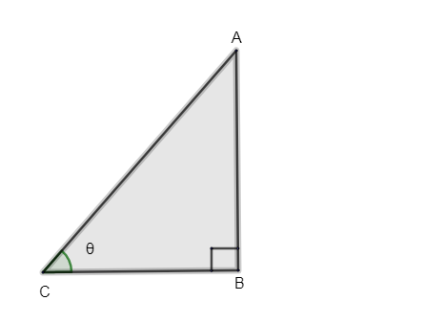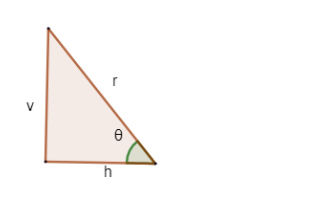
Prove the following identity \[{{\sin }^{2}}\theta +{{\cos }^{2}}\theta =1\], geometrically.
Answer
607.2k+ views
Hint: To solve this problem use Pythagoras theorem i.e. the square of the hypotenuse of the right angled triangle is equal to the area to the sum of the square on the other two sides.
Let us consider a triangle ABC, where it is right angled at \[{{90}^{\circ }}\] and angle C is taken as \[\theta \].

According to angle C \[\theta \], AB is the opposite side, BC is the adjacent side and AC is the hypotenuse.
We know the Pythagoras theorem.
i.e. the square of the hypotenuse of the right angled triangle is equal to the area to the sum of the square on the other two sides.
i.e. \[A{{C}^{2}}=A{{B}^{2}}+B{{C}^{2}}-(1)\]
Now, divide both RHS and LHS with \[A{{C}^{2}}\]
\[\begin{align}
& \Rightarrow \dfrac{A{{B}^{2}}+B{{C}^{2}}}{A{{C}^{2}}}=\dfrac{A{{C}^{2}}}{A{{C}^{2}}} \\
& \therefore \dfrac{A{{B}^{2}}}{A{{C}^{2}}}+\dfrac{B{{C}^{2}}}{A{{C}^{2}}}=1\Rightarrow {{\left( \dfrac{AB}{AC} \right)}^{2}}+{{\left( \dfrac{BC}{AC} \right)}^{2}}=1-(2) \\
\end{align}\]
where, \[\dfrac{AB}{AC}=\dfrac{opposite\ side}{hypotenuse}=\sin \theta \]
\[\begin{align}
& \dfrac{BC}{AC}=\dfrac{adjacent\ side}{hypotenuse}=\cos \theta \\
& \therefore {{\left( \dfrac{AB}{AC} \right)}^{2}}+{{\left( \dfrac{BC}{AC} \right)}^{2}}=1\Rightarrow {{\left( \sin \theta \right)}^{2}}+{{\left( \cos \theta \right)}^{2}}=1 \\
& \Rightarrow {{\sin }^{2}}\theta +{{\cos }^{2}}\theta =1 \\
\end{align}\]
Note: This is another method to prove \[{{\sin }^{2}}\theta +{{\cos }^{2}}\theta =1\]

From a right angle triangle, \[\cos \theta =\dfrac{adjacent\ side}{hypotenuse}=\dfrac{h}{r}\]
\[\sin \theta =\dfrac{opposite\ side}{hypotenuse}=\dfrac{v}{r}\]
From Pythagoras theorem, \[{{r}^{2}}={{v}^{2}}+{{h}^{2}}\]
Here, \[\cos \theta =\dfrac{h}{r}\Rightarrow h=r\cos \theta \]
\[\begin{align}
& \sin \theta =\dfrac{v}{r}\Rightarrow v=r\sin \theta \\
& \therefore {{r}^{2}}={{\left( r\cos \theta \right)}^{2}}+{{\left( r\sin \theta \right)}^{2}}\Rightarrow {{r}^{2}}={{r}^{2}}{{\cos }^{2}}\theta +{{r}^{2}}{{\sin }^{2}}\theta \\
& \therefore {{r}^{2}}{{\cos }^{2}}\theta +{{r}^{2}}{{\sin }^{2}}\theta ={{r}^{2}} \\
& {{r}^{2}}\left( {{\cos }^{2}}\theta +{{\sin }^{2}}\theta \right)={{r}^{2}} \\
& \Rightarrow {{\cos }^{2}}\theta +{{\sin }^{2}}\theta =1 \\
\end{align}\]
Let us consider a triangle ABC, where it is right angled at \[{{90}^{\circ }}\] and angle C is taken as \[\theta \].

According to angle C \[\theta \], AB is the opposite side, BC is the adjacent side and AC is the hypotenuse.
We know the Pythagoras theorem.
i.e. the square of the hypotenuse of the right angled triangle is equal to the area to the sum of the square on the other two sides.
i.e. \[A{{C}^{2}}=A{{B}^{2}}+B{{C}^{2}}-(1)\]
Now, divide both RHS and LHS with \[A{{C}^{2}}\]
\[\begin{align}
& \Rightarrow \dfrac{A{{B}^{2}}+B{{C}^{2}}}{A{{C}^{2}}}=\dfrac{A{{C}^{2}}}{A{{C}^{2}}} \\
& \therefore \dfrac{A{{B}^{2}}}{A{{C}^{2}}}+\dfrac{B{{C}^{2}}}{A{{C}^{2}}}=1\Rightarrow {{\left( \dfrac{AB}{AC} \right)}^{2}}+{{\left( \dfrac{BC}{AC} \right)}^{2}}=1-(2) \\
\end{align}\]
where, \[\dfrac{AB}{AC}=\dfrac{opposite\ side}{hypotenuse}=\sin \theta \]
\[\begin{align}
& \dfrac{BC}{AC}=\dfrac{adjacent\ side}{hypotenuse}=\cos \theta \\
& \therefore {{\left( \dfrac{AB}{AC} \right)}^{2}}+{{\left( \dfrac{BC}{AC} \right)}^{2}}=1\Rightarrow {{\left( \sin \theta \right)}^{2}}+{{\left( \cos \theta \right)}^{2}}=1 \\
& \Rightarrow {{\sin }^{2}}\theta +{{\cos }^{2}}\theta =1 \\
\end{align}\]
Note: This is another method to prove \[{{\sin }^{2}}\theta +{{\cos }^{2}}\theta =1\]

From a right angle triangle, \[\cos \theta =\dfrac{adjacent\ side}{hypotenuse}=\dfrac{h}{r}\]
\[\sin \theta =\dfrac{opposite\ side}{hypotenuse}=\dfrac{v}{r}\]
From Pythagoras theorem, \[{{r}^{2}}={{v}^{2}}+{{h}^{2}}\]
Here, \[\cos \theta =\dfrac{h}{r}\Rightarrow h=r\cos \theta \]
\[\begin{align}
& \sin \theta =\dfrac{v}{r}\Rightarrow v=r\sin \theta \\
& \therefore {{r}^{2}}={{\left( r\cos \theta \right)}^{2}}+{{\left( r\sin \theta \right)}^{2}}\Rightarrow {{r}^{2}}={{r}^{2}}{{\cos }^{2}}\theta +{{r}^{2}}{{\sin }^{2}}\theta \\
& \therefore {{r}^{2}}{{\cos }^{2}}\theta +{{r}^{2}}{{\sin }^{2}}\theta ={{r}^{2}} \\
& {{r}^{2}}\left( {{\cos }^{2}}\theta +{{\sin }^{2}}\theta \right)={{r}^{2}} \\
& \Rightarrow {{\cos }^{2}}\theta +{{\sin }^{2}}\theta =1 \\
\end{align}\]
Recently Updated Pages
Master Class 10 General Knowledge: Engaging Questions & Answers for Success

Master Class 10 Science: Engaging Questions & Answers for Success

Master Class 10 Social Science: Engaging Questions & Answers for Success

Master Class 10 Maths: Engaging Questions & Answers for Success

Master Class 10 English: Engaging Questions & Answers for Success

Master Class 10 Computer Science: Engaging Questions & Answers for Success

Trending doubts
Why is there a time difference of about 5 hours between class 10 social science CBSE

Write a letter to the principal requesting him to grant class 10 english CBSE

What is the median of the first 10 natural numbers class 10 maths CBSE

The Equation xxx + 2 is Satisfied when x is Equal to Class 10 Maths

Which of the following does not have a fundamental class 10 physics CBSE

State and prove converse of BPT Basic Proportionality class 10 maths CBSE




